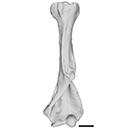3D models of early strepsirrhine primate teeth from North Africa
3D models of Pontognathus ignotus and Massetognathus pascuali
3D models of Protosilvestria sculpta and Coloboderes roqueprunetherion
3D GM dataset of bird skeletal variation
Skeletal embryonic development in the catshark
Bony connexions of the petrosal bone of extant hippos
bony labyrinth (11) , inner ear (10) , Eocene (8) , South America (8) , Paleobiogeography (7) , skull (7) , phylogeny (6)
Lionel Hautier (22) , Maëva Judith Orliac (21) , Laurent Marivaux (16) , Rodolphe Tabuce (14) , Bastien Mennecart (13) , Pierre-Olivier Antoine (12) , Renaud Lebrun (11)
MorphoMuseuM Volume 09, issue 02
<< prev. article next article >>

|
3D dataset3D model related to the publication: Occurrence of the ground sloth Nothrotheriops (Xenarthra, Folivora) in the Late Pleistocene of Uruguay: New information on its dietary and habitat preferences based on stable isotope analysisLuciano Varela
Published online: 18/05/2023 Keywords: Ground sloth; Nothrotheriidae; Nothrotheriinae; Quaternary; South America https://doi.org/10.18563/journal.m3.191 References: 4 Cited by: 1 Cite this article: Luciano Varela, 2023. 3D model related to the publication: Occurrence of the ground sloth Nothrotheriops (Xenarthra, Folivora) in the Late Pleistocene of Uruguay: New information on its dietary and habitat preferences based on stable isotope analysis. MorphoMuseuM e191. doi: 10.18563/journal.m3.191 Export citationAbstractThe present 3D Dataset contains the 3D model analyzed in the following publication: occurrence of the ground sloth Nothrotheriops (Xenarthra, Folivora) in the Late Pleistocene of Uruguay: New information on its dietary and habitat preferences based on stable isotope analysis. Journal of Mammalian Evolution. https://doi.org/10.1007/s10914-023-09660-w Specimens and 3D DataNothrotheriops sp. CAV 1466 View specimen
See original publication Published in Volume 09, issue 02 (2023) References Fariña, R. A., Tambusso, P. S., Varela, L., Czerwonogora, A., Di Giacomo, M., Musso, M. Bracco, R., Gascue, A., 2014. Arroyo del Vizcaíno, Uruguay: A fossil-rich 30-ka-old megafaunal locality with cut-marked bones. Proc. R. Soc. B. 281(1774), 1-6. https://doi.org/10.1098/rspb.2013.2211. Cited by:Luciano Varela, P. Sebastián Tambusso, H. Gregory McDonald, Raúl I. Vezzosi and Richard A. Fariña (2023). Occurrence of the ground sloth Nothrotheriops (Xenarthra, Folivora) in the Late Pleistocene of Uruguay: new information on its dietary and habitat preferences based on stable isotope analysis. Journal of Mammalian Evolution. https://doi.org/10.1007/s10914-023-09660-w |
|